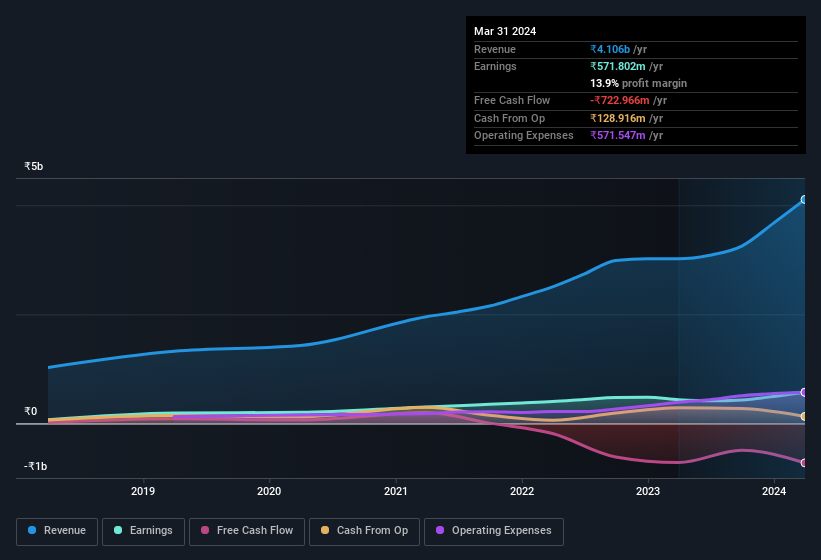Sigachi Industries' (NSE:SIGACHI) Shareholders May Want To Dig Deeper Than Statutory Profit
The market shrugged off Sigachi Industries Limited's (NSE:SIGACHI) solid earnings report. We think that investors might be worried about some concerning underlying factors.
Check out our latest analysis for Sigachi Industries

A Closer Look At Sigachi Industries' Earnings
One key financial ratio used to measure how well a company converts its profit to free cash flow (FCF) is the accrual ratio. In plain english, this ratio subtracts FCF from net profit, and divides that number by the company's average operating assets over that period. The ratio shows us how much a company's profit exceeds its FCF.
As a result, a negative accrual ratio is a positive for the company, and a positive accrual ratio is a negative. While it's not a problem to have a positive accrual ratio, indicating a certain level of non-cash profits, a high accrual ratio is arguably a bad thing, because it indicates paper profits are not matched by cash flow. To quote a 2014 paper by Lewellen and Resutek, "firms with higher accruals tend to be less profitable in the future".
For the year to March 2024, Sigachi Industries had an accrual ratio of 0.33. Therefore, we know that it's free cashflow was significantly lower than its statutory profit, raising questions about how useful that profit figure really is. Over the last year it actually had negative free cash flow of ₹723m, in contrast to the aforementioned profit of ₹571.8m. We also note that Sigachi Industries' free cash flow was actually negative last year as well, so we could understand if shareholders were bothered by its outflow of ₹723m. Unfortunately for shareholders, the company has also been issuing new shares, diluting their share of future earnings.
Note: we always recommend investors check balance sheet strength. Click here to be taken to our balance sheet analysis of Sigachi Industries.
To understand the value of a company's earnings growth, it is imperative to consider any dilution of shareholders' interests. As it happens, Sigachi Industries issued 6.8% more new shares over the last year. Therefore, each share now receives a smaller portion of profit. To celebrate net income while ignoring dilution is like rejoicing because you have a single slice of a larger pizza, but ignoring the fact that the pizza is now cut into many more slices. You can see a chart of Sigachi Industries' EPS by clicking here.
A Look At The Impact Of Sigachi Industries' Dilution On Its Earnings Per Share (EPS)
As you can see above, Sigachi Industries has been growing its net income over the last few years, with an annualized gain of 89% over three years. In comparison, earnings per share only gained 38% over the same period. And the 31% profit boost in the last year certainly seems impressive at first glance. But in comparison, EPS only increased by 28% over the same period. Therefore, the dilution is having a noteworthy influence on shareholder returns.
In the long term, earnings per share growth should beget share price growth. So it will certainly be a positive for shareholders if Sigachi Industries can grow EPS persistently. However, if its profit increases while its earnings per share stay flat (or even fall) then shareholders might not see much benefit. For the ordinary retail shareholder, EPS is a great measure to check your hypothetical "share" of the company's profit.
Our Take On Sigachi Industries' Profit Performance
As it turns out, Sigachi Industries couldn't match its profit with cashflow and its dilution means that earnings per share growth is lagging net income growth. For the reasons mentioned above, we think that a perfunctory glance at Sigachi Industries' statutory profits might make it look better than it really is on an underlying level. So while earnings quality is important, it's equally important to consider the risks facing Sigachi Industries at this point in time. Every company has risks, and we've spotted 4 warning signs for Sigachi Industries (of which 2 are significant!) you should know about.
In this article we've looked at a number of factors that can impair the utility of profit numbers, and we've come away cautious. But there are plenty of other ways to inform your opinion of a company. Some people consider a high return on equity to be a good sign of a quality business. While it might take a little research on your behalf, you may find this free collection of companies boasting high return on equity, or this list of stocks with significant insider holdings to be useful.
New: Manage All Your Stock Portfolios in One Place
We've created the ultimate portfolio companion for stock investors, and it's free.
• Connect an unlimited number of Portfolios and see your total in one currency
• Be alerted to new Warning Signs or Risks via email or mobile
• Track the Fair Value of your stocks
Have feedback on this article? Concerned about the content? Get in touch with us directly. Alternatively, email editorial-team (at) simplywallst.com.
This article by Simply Wall St is general in nature. We provide commentary based on historical data and analyst forecasts only using an unbiased methodology and our articles are not intended to be financial advice. It does not constitute a recommendation to buy or sell any stock, and does not take account of your objectives, or your financial situation. We aim to bring you long-term focused analysis driven by fundamental data. Note that our analysis may not factor in the latest price-sensitive company announcements or qualitative material. Simply Wall St has no position in any stocks mentioned.
About NSEI:SIGACHI
Sigachi Industries
Manufactures and sells microcrystalline cellulose and cellulose powder in India.
Excellent balance sheet with slight risk.
Similar Companies
Market Insights
Community Narratives



